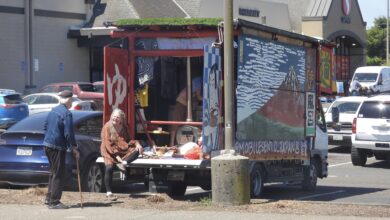Another whale stranded; search for causes of death continues
The bad news literally continues to pile up about marine mammals in 2015. More than a dozen whales have washed ashore in the last two months including a sperm whale, a humpback and an orca. More than half were gray whales.
This year’s gray whale deaths, while disconcerting, don’t compare to the gray whale die-off that happened in 1999, experts say. More than a dozen whales have washed up along the shore north of San Francisco this year. Two of those were in Fort Bragg, an orca that washed up at Mackerricher State Park in April and a gray whale that washed ashore on Hare Creek Beach on May 21. An oil spill in the Santa Barbara Channel on May 19. The area is part of the migration route for gray whales.
But interviews with researchers continue to show they feel the beachings, while disconcerting, do not appear to be signs of ant crisis in whales. A large number of whales washing up in a short period of time in a television news market has made the situation more news than crisis. Unfortunately, the situation for sea lions is as bad as reported, said Claire Simeone of the Marine Mammal Center in Sausalito, which provides veterinary services to live marine mammals found beached, along with other expertise.
Simeone said the Marine Mammal Center has rescued a record 1300 sea mammals this year.
“It’s slowed down very recently, especially up on the Mendocino Coast,” said Simeone on Friday.
Most sea lions give birth on the Channel Islands of Los Angeles. Increased ocean temperatures sent sea lion food fish, such as anchovies, into deeper and more northerly waters. The food shortage in that area led to thousands of mothers abandoning their young at about five months of age. They normally nurse the pups until one year of age.
“The fallout was extensive, all along the Coast. It is amazing how these pups made it as far north as Mendocino,” said Simeone. Simeone said there is no similar emergency in the whale population. Preliminary causes of death on the dozen whales being studied include a possible ship strike and orca attack. Many were too decomposed for a cause of death to be determined. Locally a concern has been raised about whether Navy sonar could have been involved in the deaths. And has the oil spill impacted any whales?
Simeone said there have been no whales fouled with oil so far. If oil sinks to the bottom it could contaminate the mud that gray whales scoop up to seine out their food, according to other experts. She said there is nothing to indicate sonar. Whales generally beach alive and confused in those cases.
Back in 1999, 28 gray whales washed up along the California Coast. It was part of a much bigger die off that significantly reduced the population. Many feared the world’s most healthy whale population was slipping toward endangered status with so many others. But the population has since bounced back.
“The whales have been different species with different causes of death, we really don’t think all of these things are linked together,” said Simeone. “The gray whale seems to be doing quite well.”
While that is true of the gray whale that migrates between Mexico and the Behring Sea, the gray whale on the other side of the Pacific Ocean, which migrates along Russia and Asia, is endangered. Gray whales were exterminated in the Atlantic Ocean before the modern era.
The cause of death on the orca that washed up in Fort Bragg with crab lines attached still has not been determined. Investigators have been in touch with the fishermen who the crab potts belonged to. Simeone said the preliminary results show that the entanglement happened “recently before” the death of the killer whale. The investigation is still underway. The orca that died was not an endangered Southern Resident
Killer whale but rather a transient, meaning different laws may apply.
Humboldt State University, the California Academy of Sciences and the Marine Mammal Center are all part of this year’s bonanza of whale studies. Fort Bragg’s Noyo Center for Marine Science plans display the orca skeleton alongside its blue whale skeleton. The orca will belong to the California Academy on display in Fort Bragg. This will bring the Cal Academy’s expertise and resources to Fort Bragg, said Sheila Semans, executive director.




